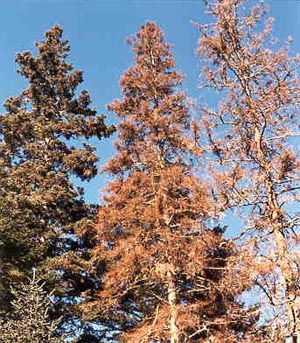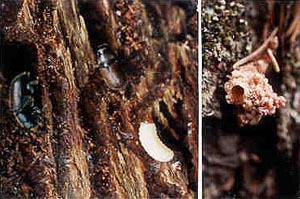DACF Home → Bureaus & Programs → Maine Forest Service → Forest Health & Monitoring → Forest Pest Index →Spruce Beetle in Coastal Maine Spruce Stands
Spruce Beetle in Coastal Maine Spruce Stands

The spruce beetle, Dendroctonus rufipennis, has become a significant threat to large and overmature white and red spruce on islands and headlands along the Maine coast. The current outbreak of this native bark beetle began with mortality of a few large spruce trees in coastal spruce-fir stands in 1992 and has steadily intensified. By 1996, more than 90 percent of the spruce over 15" in diameter were dead in some island stands off Hancock, Waldo, and Washington Counties. The spruce beetle will attack and kill healthy spruce but usually begins on heavily stressed individuals. Outbreak spread and intensity are enhanced by many factors including the presence of scattered large (>20") spruce in stands, high average stand diameter, high basal area, lack of stand management, and stand stagnation on shallow, rocky soils common on the coast. The success of recent spruce beetle attack was aided by significant droughts in the summers of 1994 and 1995 and by blowdown from recent wind storms.
The Insect
Adult spruce beetles are larger (1/4") than most native bark beetle species and vary in color from black to reddish-brown. In June, pairs of adult beetles bore a circular entrance tunnel through the bark of host trees and construct a vertical gallery. Females deposit eggs along both sides of the gallery and following egg hatch, larvae tunnel into the inner bark and cambium, horizontally from the parent galleries. Tunneling activity by larvae from numerous broods girdles the host tree, interrupts nutrient transport, and eventually kills the tree. Larvae continue to feed and grow through the summer reaching a length of 1/4" to 3/8" when full grown. Transformation from the larval to adult stage occurs within the galleries either in the fall or spring with some of the larvae overwintering in the bark galleries. New adults may remain in galleries through the winter or may emerge in late August or September and reenter bark at the base of trees.

Symptoms
Foliage becomes yellowish-green to reddish-brown in color once heavy feeding by spruce beetle larvae has disrupted the nutrient flow of infested spruce trees. Pitch tubes, small "volcano shaped" masses of pitch and insect waste, around entrance holes are also symptomatic of spruce beetle attack. When populations are relatively low, an attacked tree may survive the first year but, spruce beetles will reinfest the tree until it eventually succumbs. Trees may be inundated by adults and can be killed in a single season when beetle populations are high. The inner bark and cambium of these heavily attacked trees are often completely destroyed in such a short time that tree crowns remain green for months after the tree is dead. Heavily infested trees often change color in the late fall and lose all their needles by the following spring. Spruce beetles attack the largest trees in a stand first and then spread to other nearby large trees resulting in characteristic 'pockets' of spruce mortality.
Managing Spruce Beetle
A good, ongoing forest management plan is the best means of maintaining stand vigor and preventing a future spruce beetle problem in younger coastal spruce stands. Stand vigor may be improved by thinning large, overmature trees from coastal spruce stands not currently under attacked. Both the average diameter of the stand and the stand basal area should be reduced. Salvage operations in heavily infested stands can often save some of the merchantable wood, encourage stand regeneration, and reduce the fire and recreational hazard presented by large amounts of dead wood.
MAINE DEPARTMENT OF AGRICULTURE, CONSERVATION AND FORESTRY
Maine Forest Service - Forest Health and Monitoring Division
June 2005